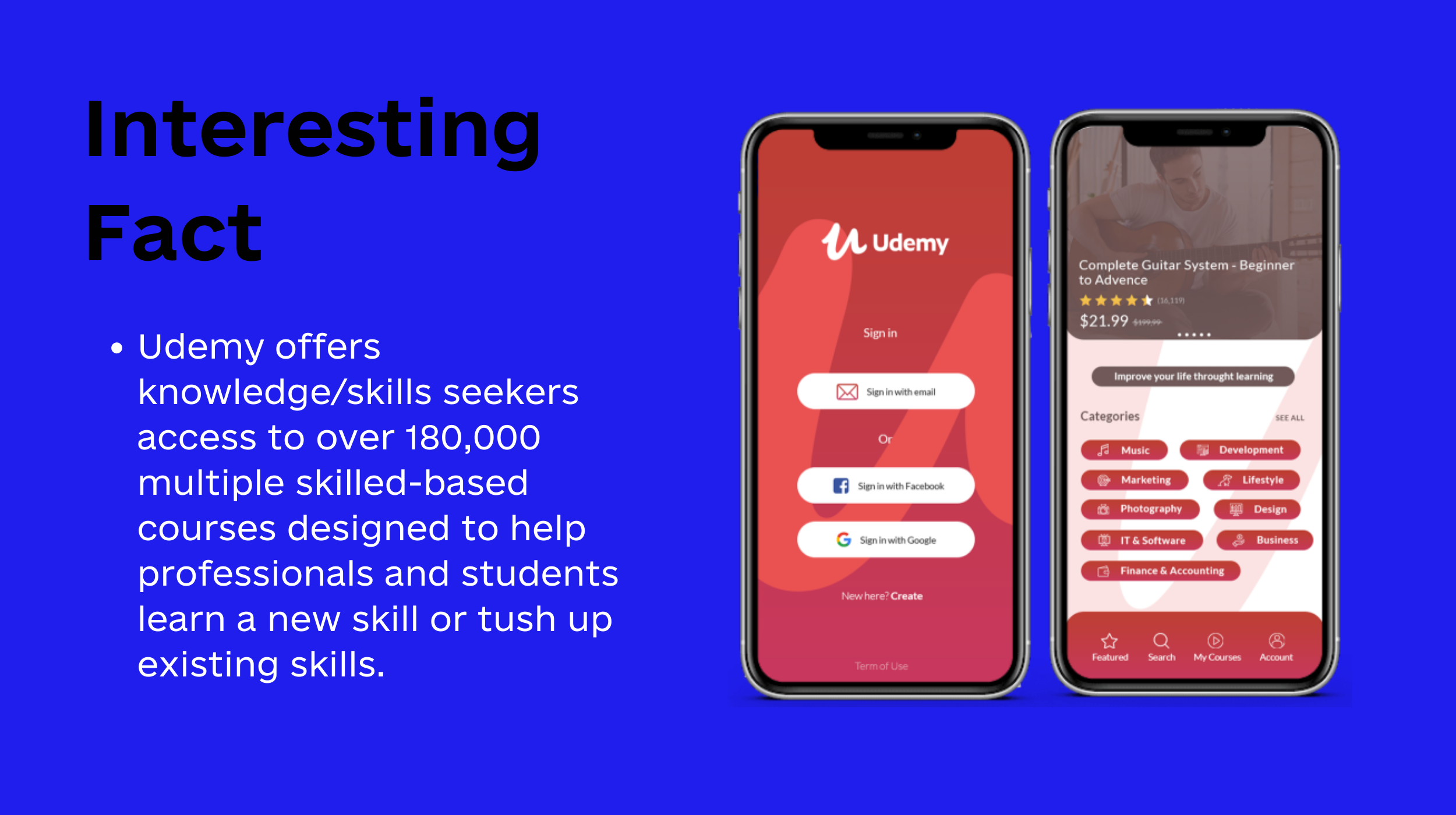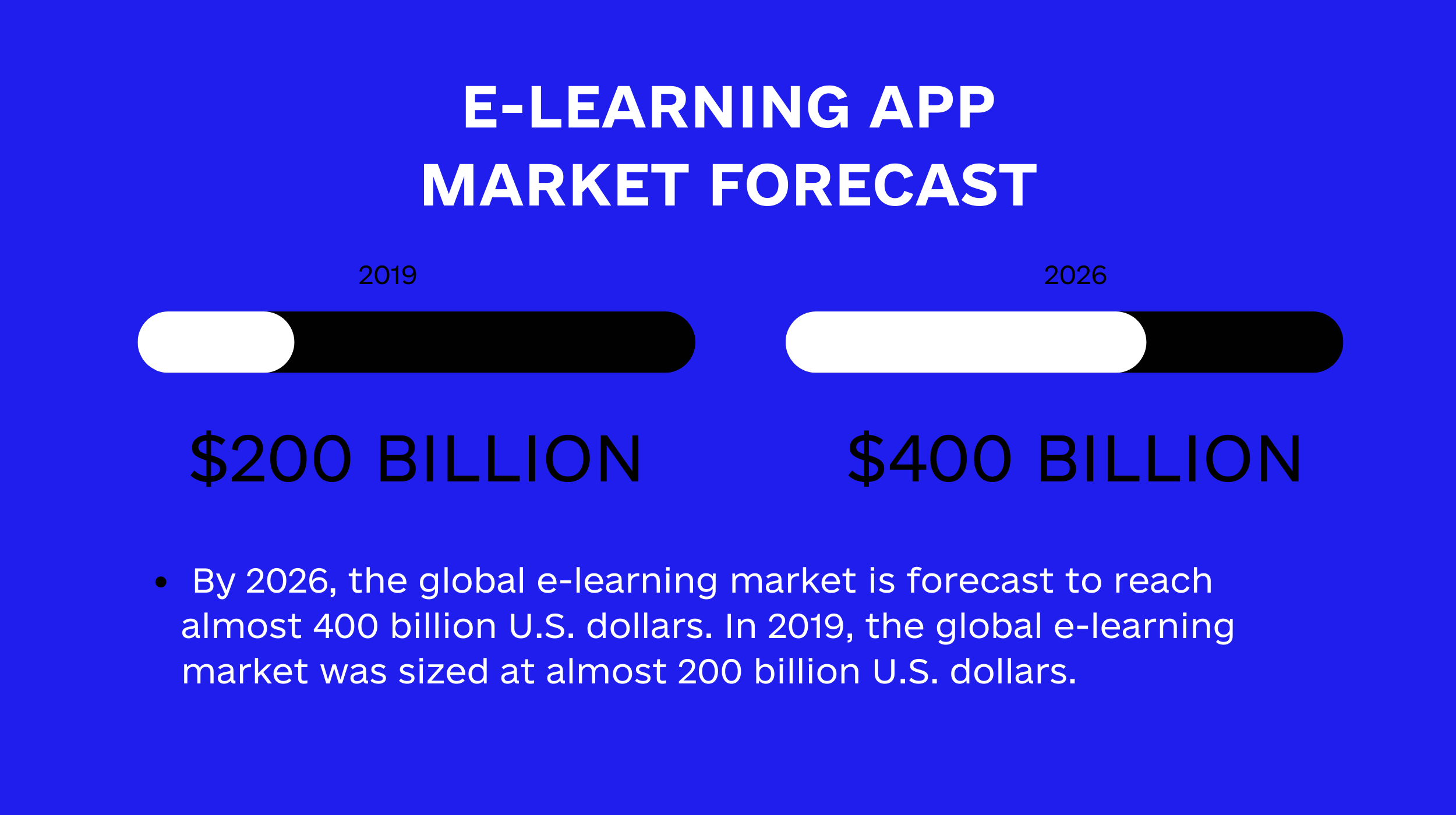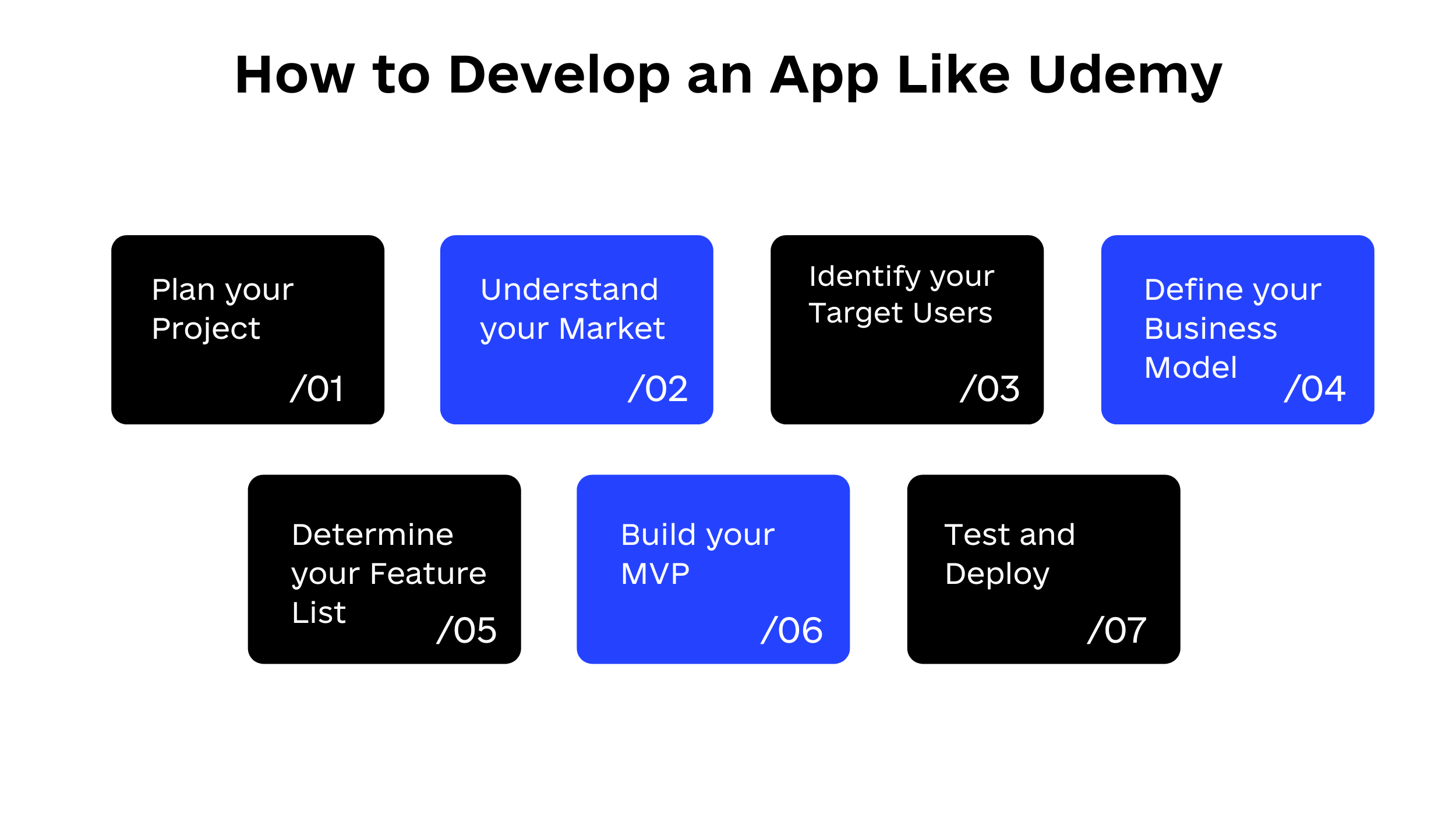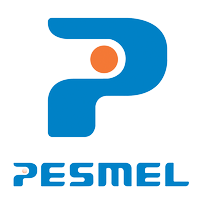While the traditional learning style is becoming more expensive, boring, and more theoretical than practical, digitalization and advances in technology are paving the way for the growth of online learning platforms. Today, most corporations, professionals, and students are turning to e-learning platforms to acquire skills that are not just theory-based but have practical application to real-life problems.
The e-learning market has grown significantly over the years, with top e-learning platforms like Udemy and Coursera registering massive growth in the last decade. The success of these two companies has opened the eyes of entrepreneurs and developers to the immense potential in the e-learning market. However, if you must benefit from this market, you must be very informed.
In this guide, we will share everything you need to know about building an e-learning app like Udemy.
Table of Contents
- 1 What is Udemy?
- 2 Market Overview
- 3 Why Should You Create an E-learning Platform Like Udemy?
- 4 Features Required to Build an E-Learning App like Udemy
- 5 Step-by-step Guide on How to Make an App Like Udemy
- 6 What is the Right Tech Stack for Building an eLearning App?
- 7 How Much Does It Cost To Create an Udemy-Like Website?
- 8 Major Takeaway
What is Udemy?
- Udemy is one of the best online marketplaces connecting buyers(learners) and sellers(tutors). As an online learning platform, Udemy offers knowledge/skills seekers access to over 180,000 multiple skilled-based courses designed to help professionals and students learn a new skill or tush up existing skills.

- Udemy is not considered an accredited institution, and as such, certificates issued for the paid-for courses can not be used for formal accreditation when seeking employment. However, users can translate the certificates issued into a pool of acquired skills that will bring value to the workforce of any organization.
Udemy Stats and Facts
To have a clear picture of why building an app like Udemy is a worthy venture, let’s look at some important facts and stats about Udemy.
- Udemy is headquartered in San Francisco and was founded by Gagan Biyani, Eren Bali, and Oktay in 2010. Currently, the platform is presided by Gregg Coccari.
- Udemy offers over 185,000 courses and boasts 425 million enrollment, with an average of 2,700 enrollments.
- About 50% of courses on Udemy are centered on business and technology fields and are responsible for about 70% of the total enrollment.
- There are over 52 million students registered on Udemy, with more than 65,000 instructors teaching in over 75 languages.
- 90% of courses on Udemy are paid for and cost between $19.99 to $199.99
- Since its inception, Udemy has raised $311.4 million in over 22 funding rounds. And currently has about 36 investors.
- Udemy went public on October 29, 2021, at an IPO share price of $29 and raised $421million.
- AT IPO, Udemy was valued at $4 billion.
As of the time of this write-up, Udemy has 49 employees.
How does Udemy Work?
Udemy operates a marketplace business model where instructors can sell their courses to companies, professionals, and students seeking to acquire new skills or fine-tune existing skills. The Udemy learning platform is merely a connector that connects over 60,000 instructors to millions of students on the platform without owing any of the courses. Udemy does not possess any exclusive rights to the courses instructors are selling. Rather they have access to host the courses on their platform and make them accessible to their users. At the point of registration, users can choose to sign up as students or as instructors.
The Udemy platform is designed to offer students a flexible learning schedule without any time limit to complete the course. Also, being a global learning platform, Udemy offers students a variety of instructors and courses at very cost-friendly rates. The typical price of the Udemy course starts from $19.98. And the instructors earn a percentage of these fees after tax. The instructors’ remuneration is as follows:
- Instructor promotions: When a student purchases their content through a teacher’s coupon or referral link, the instructor receives 97 percent of the revenue.
- Sales via Udemy’s promotions: Instructors receive 37 percent of the money from any Udemy sales that do not involve an instructor coupon or course referral link. These sales may occur after a user clicks on an Udemy advertisement or searches for courses on the Udemy marketplace.
Market Overview
Some factors driving the growth of e-learning in the business and academic world include rapid advancement in internet technology, enhanced internet connectivity, bandwidth expansion, and the introduction of 5G networks. In addition, the development of cutting-edge e-learning technologies(gamification, A.R. & V.R.), increased penetration and adoption of mobile devices for educational purposes, the shift of the corporate world to BYOD, incorporation of learning and training sessions via mobile devices, and intriguing government policies favoring the use of technology in the academic sector has seen the E-learning market smashing through the roof.

📈 According to Statista, in 2019, the e-learning market was sitting at almost $200 billion and was projected to be worth nearly $400 billion By 2026. The learning management system (LMS) market generated roughly 18 billion U.S. dollars in the same year. But according to a new report, it appears that the e-learning market is warming up for a huge leg-up in the coming years. And the major driver for this growth is the increased internet connection penetration across the globe. The International Telecommunication Union reported that in 2021, almost 4.9 billion people used the internet worldwide compared to 4.1 billion just two years ago. As the number keeps growing, more people will be able to use E-learning services, thus giving ample room for the market to grow.
📊 In their new report, Global Market Insight opines that the e-learning market will grow at a 20% GAGR from 2022 and be worth 1 trillion in the next six years. By 2028, the mobile eLearning market size is expected to experience a growth rate of 25%, all thanks to firms’ increasing focus on incorporating emerging technologies such as A.I. and V.R. to increase learners’ engagement during online learning. As a result, companies are focused on building a more dynamic and flexible interface. Additionally, technological developments will increase market earnings by allowing for the development of robust e-learning platforms. If this isn’t a clear signal to build an app like Udemy and benefit from this market, I wonder what is. But before we delve into the core aspects of developing an app like Udemy, let’s first familiarize ourselves with the benefits that Udemy offers.
Why Should You Create an E-learning Platform Like Udemy?
- The opportunity to cash in on an emerging market
The promising growth stats on the e-learning market is among the best reasons to consider building an E-learning app. According to stats, the E-learning market is expected to gross $400 billion in the next four years and touch $1 trillion in the next six years at a CAGR of 20%. The Mobile E-learning market is also poised to witness a 25% growth rate between 2022 and 2028. Relying on the stats, it is clear that the market is quite promising, and now is the best time to develop a product that can meet users’ ever-growing needs.
- Increase demands for seamless online learning
Corporations, schools, universities, and individuals are keen to embrace a different format because it allows them to access instructional content at any time, irrespective of their location and at their convenience. For instance, institutions like the University of Pennsylvania and the University of Florida currently offer full online studies designed to help students from all over the world access knowledge at their convenience. Developing an e-learning app that can satisfy the increasing appetite for online learning is one sure way to meet a real global need while generating revenue.
- Opportunity to serve a wide variety of audience
Another key benefit of building an online learning platform is the opportunity to serve a wide variety of users from different sectors, industries, and geographical locations. The opportunity to serve a wide variety of audiences could increase specialization and eliminate or reduce competition with key players to a large extent. For example, Udemy, Coursera, and Skillshare cater to diverse users, including marketers, designers, authors, programmers, etc. Platforms like Udacity and Pluralsight cater to the needs of computer specialists, I.T. executives, and corporate executives. You can design your system to meet the needs of even a more specific market niche with a competitive advantage over key players in the market.
This means that none of these systems can meet the needs of every user group. As a result, you can create a website similar to Udemy but for a certain age range and speciality areas, such as designers, photographers, or corporations looking to train their personnel. It will relieve you of the need to compete with market leaders and provide you with a competitive advantage.
- Opportunity to access funds
Lastly, the huge increase in funding across the globe is another compelling reason to consider creating an E-learning platform. For example, according to the report, edtech start-up firms in the United States raised $2.2 billion in funding in 2020, the greatest investment rate for an e-learning market in a single year. Investors are willing to provide funding to back up prospective entrants, inspired by the incredible success of Udemy, Coursera,.etc. As a result, now is a wonderful moment to get your MVP ready and pitch to investors in the start-up accelerator program.
Features Required to Build an E-Learning App like Udemy
- Profile
In developing an e-learning app like Udemy, you must provide users with all the tools necessary to develop and manage their profiles. Users should have access to intuitive sign-ups, be able to select whether they want to be students or instructors, set up payment methods, and track progress.
- Filtering and intuitive search
Regardless of the number of courses your platform offers, users should be able to navigate between them using sophisticated search, course filtering, a rating system, and sorting. This way, users can easily pull out their preferred courses from the numerous courses offered on the platform without getting overwhelmed.
- Courses Management
Your app must have a Courses management feature enhanced with various tools that make creating, managing, purchasing, and using coursing on the platform a delight.
Instructors’ tools include course building, updating, displaying reviews, attaching files, creating quizzes, and tracking data.
Learner tools include a video player, a course description, feedback and rating section, lesson completion status, task attachment, and a proficiency check.
- Notification systems
Ensure that your product has provision for email and platform-based notifications or push notifications to alert users on the latest happenings and offers available.
- Admin Dashboard Panel
This will provide Admins with the necessary tools to manage users, contents, notifications, and mailings and generate reports and analyze data.
- Customer support systems
This feature helps to ensure that challenges and inquiries from users are attended to on a timely basis. You should include a live chat system, Chatbot, or FAQ section to help users maximize the full potential of your platform.
- Analytics in Real-Time
Real-time data are used to evaluate an app’s efficiency and how users interact with the platform. This tool makes it simple to stay abreast of course activities, assignments, student performance and grades, course completion, and overall learning growth.
- Multiple Language system
Except you want to run a very localized e-learning platform incorporating your e-learning app with different languages will help you serve a wilder market niche and develop a top-notch E-learning software similar to Udemy.
- Download option
Sometimes, students may not be able to live stream video lessons and tutorials due to network challenges, high cost of data, or other personal reasons. Integrating an option that allows students to download instructional content to study over a convenient note is a huge plus for users. For instance, Udemy offers students the option of downloading live classes for later consumption at their convenience.
- Recommendations
Develop a collection highlighting the best credentials, popular courses, best-selling courses, and instructors. These suggestions will assist students in discovering new and intriguing topics without any hassles. Also, it will help new subscribers will have a solid idea of to begin their learning journey.
Step-by-step Guide on How to Make an App Like Udemy
Developing an app like Udemy may seem arduous, but you can achieve your goal with less hassle with the simple steps outlined below.

Step#1. Plan your Project
A popular saying is that those who do not plan are inevitably planning to fail. This statement holds true in every facet of life, and project development is no exception. In developing an app like Udemy, you can’t just jump in and start working.
E-learning application development: Process, Features, and Cost
It would be best to have a detailed and solid plan to define the development flow. In this stage, you will have to decide on the following:
✅ The size of your app.
✅ The resources needed to get an MVP working.
✅ The team structure.
✅ Whether the developers will be in-house or an independent third party.
✅ Whether the app will be built from scratch or bought on white label solution
✅ The development time.
Once you have sorted out this stage and outlined them in a detailed manner, you can move to the next.
Step#2. Understand your Market
The e-learning market is not new, and as such, there are many companies already offering online learning services. But being aware of this should not deter you from building your solution. Rather it should help you understand who the major players are and what they are currently doing to match the appetite of people seeking to learn or boost their skills online. Below are some questions to focus on when trying to understand the market:
✅ Who are the current players in the online learning market?
✅ What are the challenges hampering their ability to meet users’ needs?
✅ Which learning categories are important or growing but receive the least attention from major players?
✅ What are the major factors driving the growth of e-learning around the globe?
✅ What are the major trends reshaping the e-learning market as we know it?
✅ And what is the growth forecast for the e-learning market?
Finding the right answers to these questions will help you properly structure your e-learning app for success.
Step#3. Identify your Target Users
In this phase, you need to focus on identifying your potential app users and figure out their pain points with current platforms. Your goal here is not to develop an app for business as usual but rather to develop an app that will address customers’ pain points with existing platforms. Below are some questions to help you identify your target audience.
✅ Which regions have the most structures for e-learning to thrive?
✅ Which market region is emerging?
✅ What is the age group of people using e-learning platforms to earn or boost their skills?
✅ What is the purchasing power of people within your identified region and age group?
✅ Which niche are internet users moving to that receives the least attention?
Attending to these questions will help you streamline your focus to what is important and get the most out of the market. For instance, e-learning platforms like Udemy, Coursera, and Skillshare have streamlined their users to capture diverse users, like marketers, designers, authors, programmers, etc. Platforms like Udacity and Pluralsight cater to the needs of computer specialists, IT executives, and corporate executives. You should also design your platform to meet the core needs of a specialized group of users. For instance, the blockchain industry is rapidly growing, but many people do not even understand how to tap into this space and maximize the limitless potential therein. You can target the users in the blockchain industry and build a name for yourself.
Note: restricting your target to specific users in an industry may be limiting and not advised. However, you should be known for users in a/some specific sector.
Step#4. Define your Business Model
Most entrepreneurs get carried away by the euphoria of building a product that they forget to have a solid monetization plan, and they are soon out of business. If you want to succeed, you need to determine a monetization strategy that best suits your business idea. Below are some popular monetization strategies adopted by top players like Udemy and Coursera:
- Paid certificates
This strategy has received the most patronage among e-learning platforms. Here, students of a given platform get awarded a certificate after completing a paid course’s learning requirement. - Monthly subscription
Here, users can only access instructional material on a subscription basis. Udacity is a good example of an e-learning platform that allows users to access their resources after paying a monthly subscription. - Premium account
An e-learning platform like Skillshare employs this monetization strategy. This strategy aims to rope in users by offering limited access to services to build an appetite. But for users to access the platform’s full potential, they will need to upgrade to a premium account. - eLearning for businesses
It is typical for multinational businesses to plan a regular skill-up session for their employees. This is where eLearning sites like Udemy come in handy. Both Udemy and Coursera provide the necessary resources and guides for employees to learn. In the case of Coursera, corporate e-Learning has become a lucrative stream of revenue. According to Forbes, the e-learning platform made $140 million in 2018 thanks to partnerships with 1,800 businesses. Adobe, for example, paid Coursera $150,000 for machine-learning training for its employees.
Step#5. Determine your Feature List
Streamline your preferred feature list to reflect the findings in your research. Do not overkill your app with numerous features. Approach your choices of features from a minimalist perspective, and only include features that help bring life into the learning processes. Below are some key features to include:
– Profile
– Categories
– Course management
– Notification system
– 24/7 Customer System
– Analytics in real-time
– Multiple language system
– Recommendation
– Download Option
– Payment portal
– Stabilization and Delivery
– Admin Dashboard panel
Step#6. Build your MVP
Once you are pretty sure of your plan, market niche, target users, business strategy, and features list, proceed to build your MVP. The purpose of building an MVP is to help you validate your idea in real-time. Building an MVP also help you cut cost since the focus is on building a solution with the most important features to create a foundation for your app’s future. After creating MVP, you can get feedback from your users to find out the areas that need improvement.
Also, the MVP helps you test your monetization strategy to find the best fit as you grow and improve your solution.
Step#7. Test and Deploy
The last stage of developing an app like Udemy is the testing and deployment phase. The catch is to ensure that there are no inconsistencies in the code, UI/ UX designs, features, and business requirements. If you are working with an independent contractor, ensure that the software company has QA engineers on their team to run routine checks at every stage of the development.
Before deployment, employ synthetic testing to stimulate users’ behaviours on the app and fix any issues identified in the process. Once you are certain that everything checks out, you can proceed to deploy your app into the market.
But remember, don’t stop upgrading and improving your app’s ideas to accommodate feedback as they come in. also, occasionally deploy real-time monitoring to get data and activities of users as they interact with your app in real-time. Fix any issues that pop up during this testing, and you are good to go.
What is the Right Tech Stack for Building an eLearning App?
The choice of tech stack to use in developing an eLearning app is largely dependent on your in-house team or development company’s choice. However, there is a generally accepted tech stack that most players in the sector use. Let’s take a look at them in the table below.
| Feature | Tech Stack |
|---|---|
| Front end | HTML, CSS for UI part; JavaScript (AngularJS/ReactJS) for implementing FE logic |
| Back end | JavaScript (Node.JS), PHP (Laravel/Symfony), Python (Django, Flask) |
| Database | MySQL, MongoDB |
| Cloud Storage | AWS, Azure, Heroku |
How Much Does It Cost To Create an Udemy-Like Website?
The cost of developing a Udemy-like app is largely subjective. It depends on factors like:
- The nature and complexity of the app
- The number of features
- Choice of a tech stack
- Development time
- Number of developers
- And the location of developers.
For instance, the hourly rate of developers in the USA ranges between $120-$150, while in the U.K., it ranges between $75-$100. A cost-efficient choice may entail looking towards countries in Eastern Europe for the same quality as that in the U.S. Software developers in countries like Poland or Ukraine charge between $34.5-$40 per hour.
For you to arrive at a clear estimate of what you should budget for your Udemy-like app, Please take a look at this cost breakdown from the perspective of an MVP.
| Features | Duration(Hrs) | Cost($34.50) |
|---|---|---|
| Home page | 84 | 2898 |
| Profile | 150-200 | 5175-6900 |
| Filtering and intuitive search | 64 | 2208 |
| Course management | 380-480 | 13100-16560 |
| Notification | 32 | 1104 |
| Payment gateway | 80-100 | 2760-3450 |
| Shopping cart | 64-128 | 2208-4416 |
| QA | 300 | 10350 |
| Reviews and ratings | 68 | 2346 |
| UI/UX development | 100 | 3450 |
| Architecture (project setup & DB structure) | 32 | 1208 |
| Stabilization and Delivery | 72 | 2484 |
| Admin Dashboard panel | 500-1000* | |
| Total | 1426-1660 | 49 197-57 270 |
*Depends on the requirements of the customer.
Note: the hourly rate is based on our pricing at Code&Care.
Major Takeaway
The e-learning market is still emerging, and with the increase in mobile phone and internet usage, it is safe to conclude that the market is yet to maximize its limitless potential. Currently, platforms like Udemy, Coursera, Udacity, Pluralsight, etc., have already taken up seats as key players. Blindly trying to replicate their systems will be a recipe for failure, or you will get lost in the crowd at best. Therefore, you must come up with a unique product idea that can set you apart from the major players in the industry.
Therefore, if you have an e-learning idea that you do not only want to bring to life but want to ensure it succeeds, we will be glad to share our wealth of experience with you. Don’t hesitate to get in touch with us here for more.
Read also:
How to Build a SaaS Product from Scratch [A Practical Guide]
How to Make a Site Like Pinterest That Exceeds Users’ Expectations
















Popular
Latest